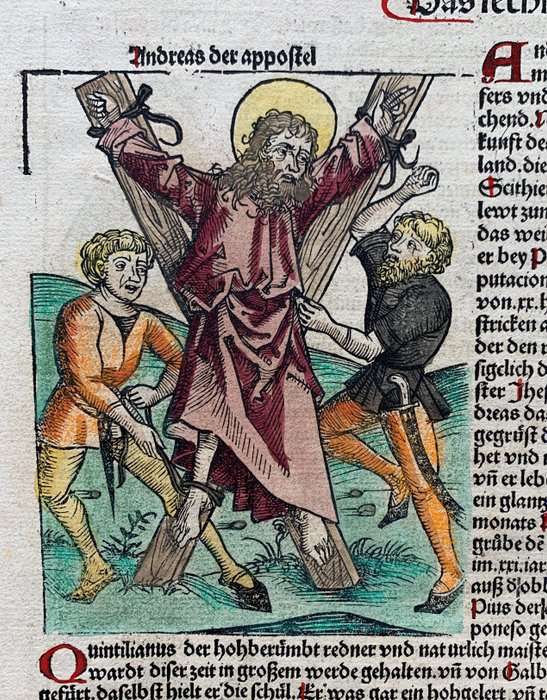
Hartmann Schedel / Michael Wolgemut/ Wilhelm Pleydenwurff - The Nuremberg Chronicle (Liber Chronicarum) - 1493
No. 81785737

No. 81785737

Original incunabulum woodcut leaf CVI (Folium 106) from the Nuremberg Chronicle of Hartmann Schedel, the first Latin edition from 1493.
An incunabulum (cradle print) is a book printed in Europe before 1 January 1501, when the printing press was still in its infancy, and of which the text is set in movable type. They are now rarely seen on the market.
The Nuremberg Chronicle (Liber Chronicarum) by Hartmann Schedel is one of the most famous and best illustrated incunabula. The beautiful woodcuts were made by Michael Wohlgemut (1434/37-1519) and his stepson Wilhelm Pleydenwurff (1450-1494), a teacher of Albrecht Dürer. Dürer probably also contributed to the execution of many of the woodcuts for this incunabulum.
The beautifully coloured woodcuts of folio CVI on the recto side show 4 different illustrations:
1. Galba - The seventh Roman emperor, known for his awkward physical appearance and various characteristics, such as his inclination to licentiousness, avarice, and lack of consideration.
2. Otho - The eighth Roman emperor, born of noble descent but known for his profligate and immoderate ways. He committed suicide by self-inflicted wounds.
3. Vitellius - The ninth Roman emperor, of honorable but not noble lineage, known for his wantonness, cruelty, and gluttony. H
4. Vespasian Flavius - The tenth Roman emperor, who reestablished the empire after a period of uncertainty and war between three princes. He was a mild and gifted man who embellished Rome and restored public welfare.
On the verso side, three beautiful illustrations are depicted:
1. Andreas - Brother and associate of Simon Peter, one of the twelve apostles of Jesus. He preached the Gospel, converted many people, and was eventually martyred on a cross in Patras, Achaia. His remains were later transferred to Constantinople.
2. Quintilian - A celebrated orator and philosopher, native of Spain, who established a school in Rome under the patronage of the emperor Galba. He wrote extensively on the art of oratory, and his lost book on oratory was rediscovered in a monastery during the 15th century.
3. Thomas Didymus - Also known as Thomas the Apostle or Doubting Thomas. He was one of the twelve apostles of Jesus and is best known for doubting the resurrection of Jesus until he saw him personally. Thomas preached the Gospel in various regions, including Parthia, Media, Persia, and India. He was eventually martyred, likely by being speared, and his body was taken to the city of Edessa.
This is not a facsimile edition, but an original leaf printed in the 15th century - so 531 years old!
Rare in coloured version.
Dimensions: 53 x 30 cm
Good condition.
How to buy on Catawiki
1. Discover something special
2. Place the top bid
3. Make a secure payment